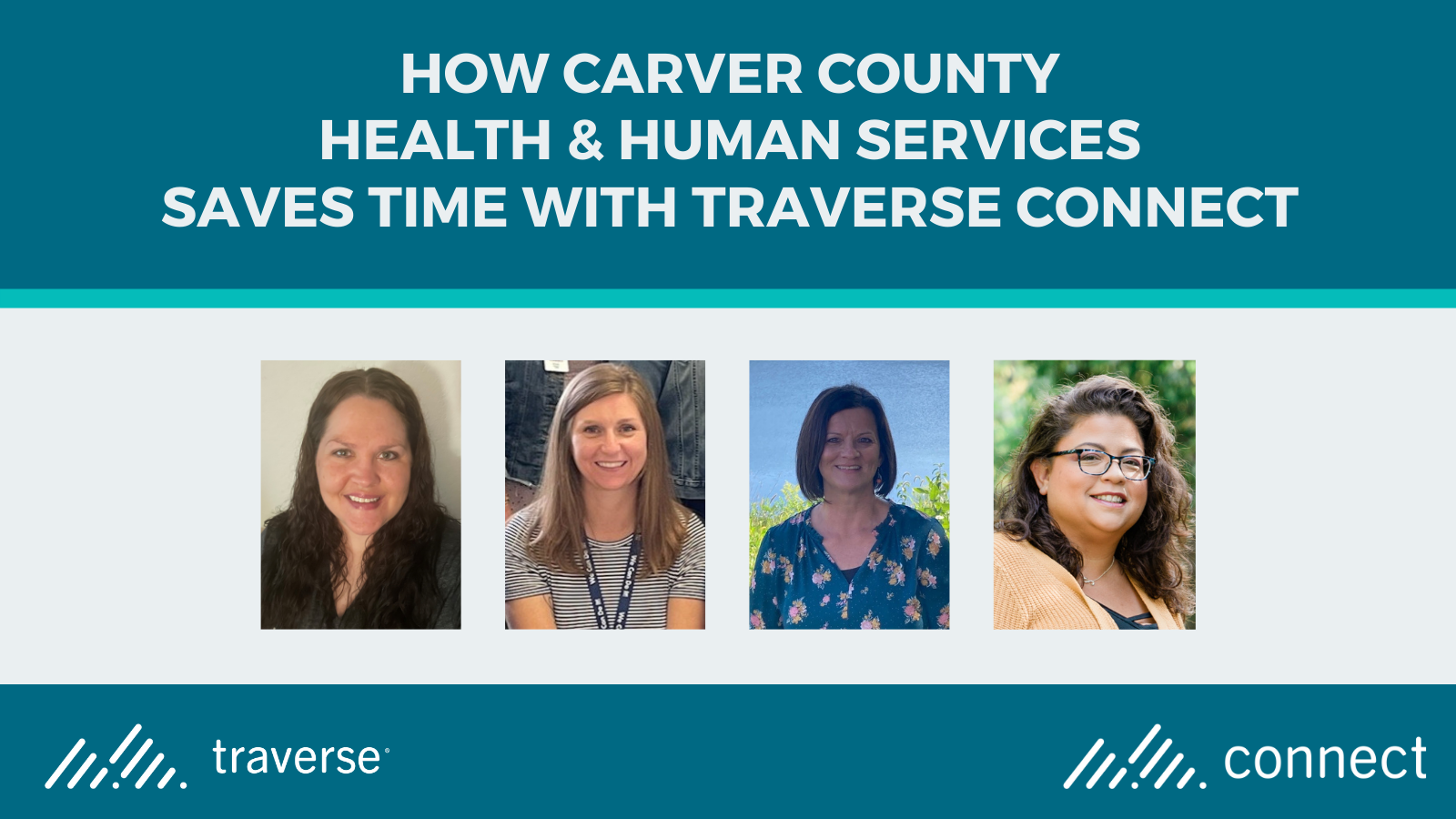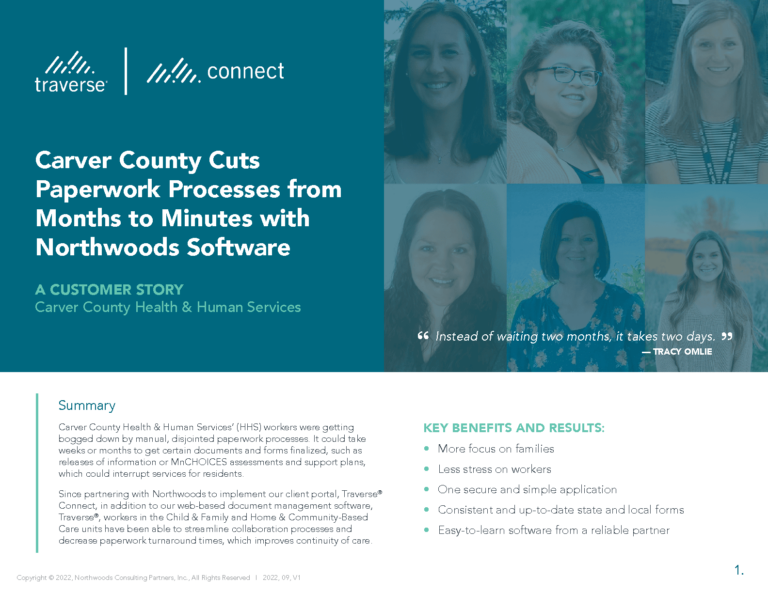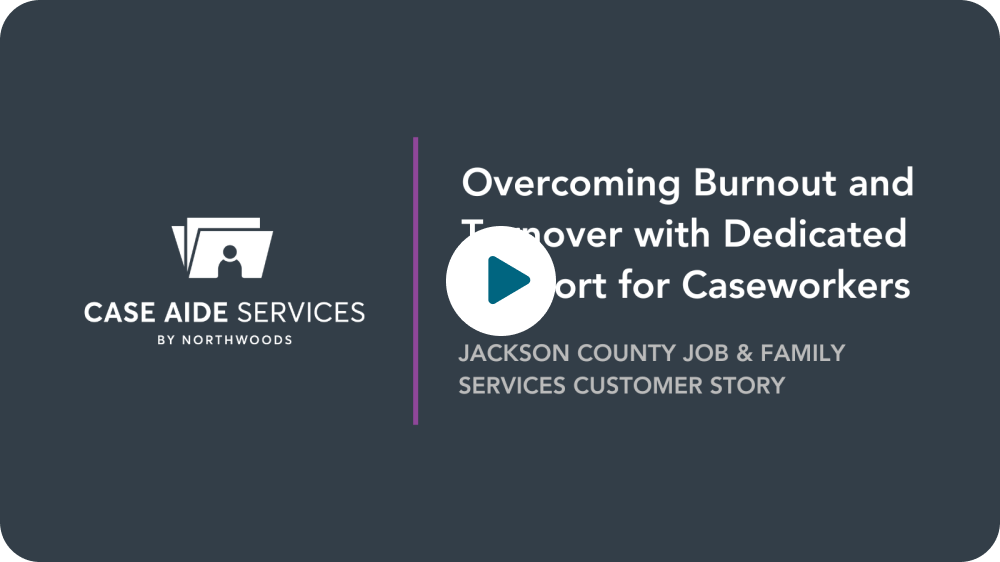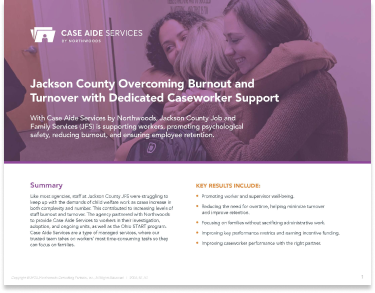Carver County Cuts Paperwork Processes from Months to Minutes with Northwoods Software
One secure application for managing forms and paperwork is helping workers across multiple programs at Carver County Health & Human Services (HHS) save time and focus on serving the community.

Summary
Carver County HHS’ workers were getting bogged down by manual, disjointed paperwork processes. It could take weeks or months to get certain documents and forms finalized, such as releases of information or MnCHOICES assessments and support plans, which could interrupt services for residents.
Since partnering with Northwoods to implement our client portal, Traverse® Connect, in addition to our web-based document management software, Traverse®, workers in the Child & Family and Home & Community-Based Care units have been able to streamline collaboration processes and decrease paperwork turnaround times, which improves continuity of care. Key benefits and results:
- More focus on families
- Less stress on workers
- One secure and simple application
- Consistent and up-to-date state and local forms
- Easy-to-learn software from a reliable partner

– MICHELLE THACKERY, Case Aide, Carver County Health & Human Services

Carver County Cuts Paperwork Processes from Months to Minutes with Northwoods Software
One secure application for managing forms and paperwork is helping workers across multiple programs save time and focus on serving the community.
Challenges
Carver County HHS’ workers in the Child & Family and Home & Community-Based Care (HCBC) units were getting bogged down by manual, disjointed processes for completing paperwork. It could take weeks or months to get required documentation and signed forms back when hard copies and mail were involved, which could cause delays or interrupt services for residents.
Time-consuming processes
“I would type up all the paperwork, save it to my computer, print it out, and mail it to my families. Sometimes we would get things back a few weeks later and most often maybe a month or two later. Occasionally paperwork could get misplaced, and we would have to send it again. If something wasn’t filled out correctly or needed some additional information, we’d have to remail it out,” said Michelle Thackrey, Case Aide.
Even sending things electronically required multiple steps and programs, which made the process lengthier and more confusing. “They usually ended up having to print stuff off themselves on their end, sign it physically and then scan it back to us, which really kind of negates the whole idea of digital signatures,” said Melissa Mak, MnCHOICES Assessor.
Shifting to hybrid work
Existing processes simply didn’t hold up when workers couldn’t see customers in person during Minnesota’s COVID-19 peacetime emergency and now that they work in a hybrid model.
Even workers who do see families in person now are still adjusting to this new way of working. For example, Ashley Stender, Family Finding Social Worker, said that it can be time-consuming having to drive to the office to get everything together before going out to see a family if she didn’t have the necessary paperwork on her or at home.
Impact on families
“If we didn’t have that paperwork or if there were mailing delays, then their services were also delayed, which then in the home is causing behaviors and disruptions and sometimes hospitalizations. It was a nightmare,” said Rachel Rosckes, Social Work Case Manager in HCBC.
“The relative and the children are delayed in getting put into our system, which means that then they can be delayed in getting their payments and getting set up on medical assistance or other needed things like that,” Ashley said.
Keeping information secure
Disjointed processes often created security concerns, especially when sharing information with other counties or outside providers.
“If I tried to send five documents from my Outlook email to an outside agency, our automatic policy at the county was that it would get encrypted because it had certain information in it. That’s when the outside provider then would have a lot of issues with trying to open those attachments, never receiving them, or having problems in general just accessing those documents,” Melissa said.
Meeting mandates
Home and Community-Based Care Manager Brian Esch said mandates for required signatures and sharing documentation would often cause headaches for HCBC staff because there was so much paper involved in the process and it was hard to keep up with changes.
Child & Family Manager Shelly (Michelle) Selinger added that her child welfare staff felt the same burden of continual demands from legislators and the state.

Traverse Connect allows us to stay all in the same application. If you can stay in the same application and be the most efficient, that’s always going to be a win-win.”
– SHELLY SELINGER, Child & Family Manager, Carver County Health & Human Services
Solution
Carver County HHS simply needed a program that was designed to work how and where they do. “Time is always a social worker’s biggest hurdle. Anything that we could do to save time, it’s going to benefit us and we’re going to be more efficient,” Shelly said.
The agency has already implemented Traverse, our cloud-based document management, forms management, mobility, and case discovery software, to access and manage electronic case files and information that are available to everyone, regardless of location. Now, Traverse Connect helps workers engage and collaborate with clients and providers more efficiently and from anywhere too.
Traverse Connect is a secure portal built for clients, providers, and anyone outside of the agency that has a stake in the case. It simplifies collaboration, significantly reduces the time it takes to exchange information, and removes barriers and inefficiencies so that workers in both Child & Family and HCBC can focus on planning and providing the right care for the people they serve.
“Traverse Connect could be used in all sorts of different areas within our department, with pretty much any form that needs to be filled out or with a signature,” Ashley said.
Workers use Traverse Connect to share specific documents with stakeholders outside the agency and request signatures on forms. Clients, providers, or other external collaborators then use any device, wherever they are, to create a secure account to access the portal. They can view shared documents, sign forms, and upload case documentation to be automatically added to the electronic case file in Traverse once verified by a worker.
Here are some ways workers have used Traverse Connect to streamline their processes so far:
Collect missing signatures
Foster Care Licenser Angie Lunow was able to quickly collect a missing signature on a home safety checklist. “Rather than having to drive right back out to her home and have her sign on the iPad that we completed this, I was able to send her the document, and then she was able to sign it and send it right back,” Angie said. “It’s just so much more convenient. It gives me a chance to increase my customer service to everybody by being more efficient.”
Complete forms
Within five minutes, Ashley got two forms completed by a relative she needed to place kids. Previously it would have taken an hour at minimum, but most likely days if the relative wasn’t immediately available or lived outside the state. She was then able to route the completed forms to the financial department and another department within the agency that needed them right away, all within the same platform of Traverse.
Complete annual documentation
Rachel uses Traverse Connect to send required documents and forms to families to sign, and then collects the finalized versions back—all through the portal. “What used to take me two weeks with mailing information to a family took me 30 minutes from start to finish,” Rachel said. Since the final forms are automatically added to the client’s case file, it saves even more time and stress. “It’s super easy. Once they do fill it out and send it back, you don’t even have to worry about e-filing it, because it’s already done for you. You just click finish,” she added.
Collect releases of information
Tracy Omlie, Case Aide, was able to step in to help the Intake unit get a needed release of information for a personal care assistant (PCA) provider. She contacted the family and had a signed release returned in minutes. “The PCA provider needed a plan from us and the only way to do that was to get a signed release. If we didn’t have Traverse Connect, we would have been waiting who knows how long to get that release to the provider and to get the plan to them. So that was extremely helpful to able to get that back within minutes,” she said.
Prepare for audits
Melissa says getting signatures and being able to automatically add completed forms from customers to their case files will help with audits by the state. “They’re going to look for a signature on the one form that we’re supposed to get signatures on,” she said. “If it’s a client that’s open to using Traverse Connect, I’ll e-mail them to set up their account and I share the forms. Later the same day after sharing it with them, I have the signature back.”

It’s a smoother process for everyone. It goes to the parent, it comes back to us, and then we can finish it off with the provider. Instead of waiting two months, it takes two days.”
– TRACY OMLIE, Case Aide, Carver County Health & Human Services
Results
Shelly says the combination of Traverse and Traverse Connect allows Carver County HHS to achieve their goal of working in a hybrid method that supports both workers and county residents alike. “Traverse Connect allows us to stay all in the same application. If you can stay in the same application and be the most efficient, that’s always going to be a win-win,” she said.
Workers in both Child & Family and HCBC say Traverse Connect allows them to be more efficient. “It’s a smoother process for everyone. It goes to the parent, it comes back to us, and then we can finish it off with the provider, so instead of waiting two months, it takes two days,” Tracy said.
More focus on families
Perhaps most important is that paperwork no longer stands in the way of workers’ ability to get residents the services and resources they need. “When the family’s process goes faster, our process goes faster, and the provider’s process goes faster, then it doesn’t hold up services. They can move on to the next task that they need to, so we’re not slowing anybody down,” Michelle said.
This allows workers to prioritize customers’ well-being, even while keeping up with mandated requirements. “It’s not even a paperwork thing, it’s providing care to our clients,” Rachel said. “We need the paperwork, the releases of information to talk to other agencies and providers, so it helps with continuity of care too, not just remaining in DHS compliance.”
Ashley added that Traverse Connect is especially helpful during high-stress situations where families don’t want to deal with paperwork on top of everything else. “All of the forms that I would give a relative were in one spot and they didn’t have to search through stuff for it,” she said. “It saves time, and then I’m able to put that time into more conversation with the family. It’s also helpful for the family to have everything in that one spot that they can go to reference or go back to fill it out after I leave.”
Lastly, Tracy says that because workers no longer have to bug families to get their paperwork done, parents have more time to focus on what’s really important—their kids and their family.
Less stress on workers
“It’s a lot less tracking, a lot less worrying what I need to follow up on or what I need to take care of, yet it’s very simplistic,” Rachel said. “It takes worries away that you didn’t realize you were worrying about.”
Tracy no longer worries that her customers’ services may lapse because their paperwork is delayed. “My stress level about having a late service agreement is gone. I don’t have to worry about that anymore because we get the paperwork back,” she said.
Shelly also noted how the technology helps workers feel like they’re never alone. “In child welfare, one of the biggest burdens we have is when workers have the responsibility of an entire family’s or child’s safety on their own shoulders,” she said. “Being able to share that responsibility across the department to support our workers is really important.”
One secure and simple application
Workers’ increased focus on clients and the community and decreased stress levels are both a direct result of streamlined, secure paperwork processes that are all handled within Traverse and Traverse Connect. “All parts of the process can be completed in Traverse Connect. I can pre-fill forms or send forms to a recipient to fill out and sign in Traverse Connect. I can receive forms back in Traverse Connect and finish the form and it is uploaded straight to the file. The process is more organized,” Michelle said.
“We don’t have loose forms sitting around,” Shelly said. “They’re all contained in one secure application, which is Traverse.”
“The less systems that case managers have to delve into, the more they like it. They already have enough with Minnesota Department of Human Services (DHS) and programs that we have to access with them,” Brian said. “It was nice to keep it all in one package. It’s continuity and a familiar system that’s shared across many different units in different areas.”
Consistent and up-to-date state and local forms
Knowing that forms are always up to date—and consistently stored in a way that is tailored to Carver County—helps the agency keep up with requirements.
“We work in a very bureaucratic world with a lot of different programs in our area and they all had different forms that would seem to get updated every year. Before social workers would use different forms or have outdated copies. With this system we were able to lock in that when they pull up a form, it would be the most current one, which is really huge for us,” Brian said. “The biggest thing that I get concerned about as a manager is quality assurance. We have to constantly report back to the state of Minnesota what’s been done, and I think systems like this allow us to get those needs met.”
Easy-to-learn software from a reliable partner
The software is so simple that Rachel caught on even though she could only attend half of the training. “It’s literally one simple step. It takes 30 seconds to a minute to add a collaborator to the person’s case and then it’s super easy from there,” she said.
Both leadership and frontline workers also agree that having Northwoods as a partner made the process of learning and adopting Traverse Connect that much smoother. “We’re not just left to figure it out on our own or feel like we don’t have anyone to turn to if we have some big questions,” Melissa said. “I also appreciate that when we do give feedback, it’s received.”
“Northwoods has always been there, and you listen to us,” Shelly said. “It feels like you understand the world of social work and how chaotic it can be, and you’re trying to find ways to really support us.”

Traverse Connect could be used in all sorts of different areas within our department, with pretty much any form that needs to be filled out or with a signature.”
– ASHLEY STENDER, Family Finding Social Worker, Carver County Health & Human Services



